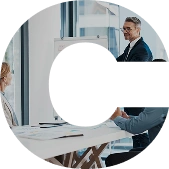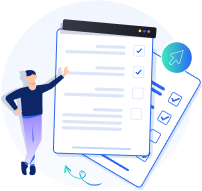Course Overview O v e r v i e w
- Course Overview
- Course Outline
- What’s Included
- What You’ll Learn
- Exam Details
AgilePM® Foundation & Practitioner (AgilePM® v3) Overview
The Agile Project Management Foundation & Practitioner (AgilePM®) Course is designed to equip professionals with a comprehensive understanding of agile principles and their practical application in project environments. Based on the AgilePM® framework developed by the Agile Business Consortium, the course covers both foundational knowledge and advanced techniques for managing projects with flexibility, collaboration, and speed.
Formal training ensures that learners gain structured insights into agile methodologies, supported by expert instruction and real-world examples. It helps participants understand how to adapt to changing project requirements, engage stakeholders effectively, and deliver value-driven outcomes. Being formally trained also enhances exam readiness and boosts confidence in applying agile practices across industries.
Training Deals offers a dynamic and learner-focused approach to AgilePM® certification. Our course includes engaging sessions led by certified trainers, practical exercises, and tailored study materials to support both Foundation and Practitioner levels. With flexible delivery formats and a commitment to quality, Training Deals ensures that every delegate is well-prepared to succeed in agile project environments.

AgilePM® Foundation & Practitioner (AgilePM® v3) Outline
Module 1: Key Concepts (KC)
- Definition of Business Agility
- Meaning Of VUCA
- Agile Manifesto and Its Enhancement for The Agile Project Context
- Scope of Product Development
- Scope of Project Management
- Why Agility Is Needed in Project Delivery
- How Agility Helps Deal With VUCA
- Values in The Manifesto
- Significance of The Final Sentence in The Manifesto
- Manifesto Principles Enhanced for The Agile Project Context
- How Project Management Differs to Product Development?
- Characteristics of An Agile Approach for A Project
- Why Agility in Project Management Is Always the Best Approach?
Module 2: Scrum Overview (SC)
- Definition of Scrum
- Scrum Values
- Scrum Team Roles and Purpose
- Name and Purpose of the 5 Scrum Events
- Scrum Artefacts and Commitments
- Scrum Theory (The Three Pillars of Empiricism)
- Scrum Events
- Scrum Artefacts and Commitments
Module 3: AgilePM Fundamentals (AF)
- AgilePM Philosophy
- Underlying Ethos of AgilePM
- How AgilePM Approaches The 4 Project Variables
- AgilePM's 8 Principles - Rules of Engagement
- AgilePM And Projects in the 'Real World'
- AgilePM's 8 Principles - Rules of Engagement
- In Combination with Scrum, What AgilePM Provides
Module 4: Individuals and Interactions (IN)
- 9 Principles of Agile Leadership
- Definition of a Stakeholder and the 3 Classes Identified:
- Project Leadership Roles
- Solution Development Roles
- External Stakeholders
- Names of The AgilePM V3 Roles:
- Leadership
- Team-Based
- Accountabilities of The Scrum Master
- What Is Agile Leadership
- How The 9 Principles of Agile Leadership Are Applied
- Interactions Between Stakeholders and What Influences These
- Project Leadership Roles and Responsibilities:
- Business Sponsor
- Business Visionary
- Solution Architect
- Project Manager
- Product Owner
- Product Owner's Relationship with the 4 Key Stakeholders:
- Business Visionary
- Solution Architect
- Project Manager
- Business and Technical Advisors
- Role of The Product Owner in An Agile Context
- How the Scrum Master Serves the Project Team
- Team-Based Delivery Roles and Responsibilities
- Key Project Manager's Relationships:
- Business Sponsor
- Business Visionary
- Solution Architect
- Product Owner
- Scrum Master
- Other Stakeholders
Module 5: Collaboration and Communication (CC)
- Collaboration
- Definition
- What It Involves?
- Characteristics of Individuals Working Collaboratively
- Communication
- Definition
- Poor Communication and Project Failure
- Communication Choices
- Jim Highsmith: "Documentation Is Not Understanding, Process Is Not Discipline, Formality Is Not Skill."
- Effective Collaboration in The Context of a Project:
- Benefits
- Building Competence
- Leading A Collaborative Team
- Effective Communication in The Context of a Project:
- Skills, Language and Technology
- Communication Planning
- Communication Choices
- Transparency of Process and Progress
Module 6: Project Lifecycle Framework (PR)
- Defining and Distinguishing Between Types of Increment
- Project Lifecycle
- Purpose, Work and Potential Work-Products for Each Lifecycle Phase:
- Pre-Project
- Feasibility
- Foundations
- Development
- Deployment
- Post-Deployment
Module 7: Requirements, Estimating and Prioritisation (ES)
- Key Concepts and Hierarchy of Requirements, Goals, Backlogs, Solutions, Products and Increments
- Definition of A Requirement and The Different Types
- User Stories
- Format (As A, I Want, So That)
- Composition (4 Cs)
- INVEST (Acronym Labels and Description)
- MoSCoW Rules
- Definition Of M, S, C And W
- Guidance In %ages Of Effort for M And C
- Requirements:
- Identifying Requirements
- Writing User Stories
- Working with Requirements Throughout the Project Lifecycle
- Estimating in An Agile Environment:
- Coping With VUCA
- Styles of Estimating
- Estimating Cycle
- Estimating Throughout the Project Lifecycle
- Application of MoSCoW:
- Contingency Built into The Scope of Features
- MoSCoW Relating to Specific Timeframes
- Using MoSCoW to:
- Ensure Effective Prioritisation
- Manage Business Expectations
- Understand the Minimum Usable Subset
- MoSCoW And the Business Case
Module 8: Planning and Control (PC)
- 3 AgilePM Planning Concepts
- 4 Agile PM Tracking and Control Concepts
- Project Planning Event
- Inputs and Their Sources (Consolidation Scrum)
- Outputs and Their Application (Backlog Refinement and Sprint Planning Event)
- How The 3 AgilePM Planning Concepts Are Applied
- Planning Throughout the Project Lifecycle:
- During Each Phase
- Between Increments
- How and When Priorities Will Work?
- Tracking Progress and Responding to Change:
- Outcome Based Measurement
- Transparency of Process and Progress
- Responding to Change
- Management by Exception
- Special Considerations When Integrating AgilePM And Scrum:
- Incremental Delivery and The Structure of a Sprint
- Project Planning Event
- How to Demonstrate Control Over Development Using Scrum:
- Stories, Tasks, Progress and The Daily Scrum
- Connecting Lean Thinking with User Stories, Backlogs, Sprints and Increments
Module 9: Risk Management and The Project Approach (RK)
- Generalised Definition of Risk, Its Sources, And Impacts
- Risk Management Integrated Within the AgilePM Approach
- Risk Linked to Agility Effectiveness, Managed Through the AgilePM Configuration
- Risk as A Consequence Of VUCA, Embedded in Daily AgilePM Management
- Agility in Practice Enhances Risk Management Capability
- Project Approach Questionnaire Identifies and Mitigates Approach-Based Risks
Module 10: Governance, Compliance and The AgilePM Products (GV)
- Definition Of:
- Governance
- Empiricism
- Cone of Uncertainty (Barry Boehm Diagram) – Estimate Accuracy for Each Phase
- Work Products Related to Financial Governance
- Product Associated with Each Phase and Its Purpose
- How Traditional Governance Differs to Agile Governance - And How This Keys to The Manifesto Values
- How to Assure Regulatory Compliance in An Agile Project
- Financial Governance in An Agile World
Module 11: AgilePM v3 Syllabus Area (LP) Lifecycle and Products Theme
- Leadership Styles and Skills (Goleman)
- Leadership Styles That Get Results
- Emotional Competencies for Leaders
Module 12: AgilePM Fundamentals (AF)
- Understand the Philosophy of AgilePM, Components, and Their Relationships
- Balance Real World Needs: Time, Cost, Quality, and Features
- Understand AgilePM's 8 Principles
Module 13: Individuals and Interactions, Collaboration and Communication (IC)
- Adopt an Appropriate Style of Agile Leadership
- Apply the 9 Principles of Agile Leadership
- Shape an Agile Team Structure
- Identify Agile Project Leadership and Team Roles
- Evaluate Whether Agile Leadership Principles Are Applied Effectively
- Assess Roles, Responsibilities, and Collaborations
- Determine the Effectiveness of Collaboration and Communication
- Assess the Transparency of Process and Progress
Module 14: Risk Management and the Project Approach (RK)
- Explain the AgilePM Approach to Risk Management
- Tailor the Project Approach to Mitigate Risk
- Differentiate Between VUCA-derived and Approach-derived Risk
- Identify Relationships in the Project Approach Questionnaire
- Use the Project Approach Questionnaire to Identify Approach Based Risk
Module 15: Defining and Estimating the Work of the Project (DE)
- Apply Key Concepts and Hierarchy: Requirements, Goals, Backlogs
- Define the Work of the Project by Lifecycle Phase
- Estimate the Work Using Appropriate Approaches
- Apply MoSCoW Rules for Prioritisation
- Evaluate the Application of Key Concepts and Hierarchy
- Assess the Prioritisation of Work
- Evaluate the Application of Estimating Practice
Module 16: Planning and Controlling the Work of the Project, Governance, Compliance, and AgilePM Products (PG)
- Apply AgilePM Planning Concepts to Each Project Phase
- Track Progress and Respond to Change
- Tailor Scrum for Multi-team Planning and Dependency Management
- Demonstrate Control Over Development Using AgilePM and Scrum
- Assure Regulatory Compliance in Agile Projects
- Explain Financial Governance Differences in Agile vs. Traditional Projects
- Assess the Application of AgilePM Planning Concepts
- Evaluate the Application of Tracking and Control Concepts
- Analyse Effectiveness of AgilePM Planning Events and Scrum Customisation
- Assess the Appropriateness of Controls Using AgilePM and Scrum
- Analyse Integration of Regulatory Compliance with AgilePM and Its Impact
- Evaluate the Application of Work-Products for Regulatory Compliance and Financial Governance

What’s included in this AgilePM® Foundation & Practitioner (AgilePM® v3)?
- Expert-led Training Sessions by Certified Instructors
- AgilePM® Foundation & Practitioner (AgilePM® v3) Exam
- Digital Delegate Pack
What You’ll Learn in this Course
This course takes you from understanding the fundamentals of AgilePM® to applying Agile practices confidently in dynamic project environments. Each stage of the journey builds your ability to deliver flexible, collaborative, and value-driven projects.
- Learn the core principles, roles, and lifecycle of Agile project management
- Learn how to structure projects with iterative planning and empowered teams
- Learn to manage risks, changes, and stakeholder expectations adaptively
- Learn to apply AgilePM® techniques across various industries and sectors
- Learn to monitor progress through timeboxing and regular reviews
- Learn how to deliver solutions that meet evolving business needs

Agile Project Management (AgilePM®) Foundation Exam Information
The Agile Project Management Foundation Exam evaluates one's grasp of agile Project Management methodologies. This certification is an excellent launchpad for those keen on establishing or advancing a career in Agile Project Management.
- Question Type: Multiple Choice
- Total Questions: 50
- Total Marks: 50 Marks
- Pass Mark: 50%, or 25/50 Marks
- Duration: 40 Minutes
- Type: Closed Book
Your certificate is received within two weeks of APMG receiving your exam paper.
Agile Project Management (AgilePM®) Practitioner Exam Information
The Agile Project Management Practitioner Exam assesses one's understanding of Agile Project Management methodologies. Essentially, this is a key certification for showcasing advanced agile knowledge, especially for those progressing from the Project Management Foundation exam and aiming for a higher trajectory in Agile Project Management.
- Question Type: Multiple Choice
- Total Questions: 4
- Total Marks: 80 Marks
- Pass Mark: 50%, or 40/80 Marks
- Duration: 150 Minutes
- Type: Open Book
Your certificate is received two weeks after the AgilePM® results are released.

Our Upcoming Batches
Mon 2 Feb 2026 - Fri 6 Feb 2026
Duration: 5 Days
Mon 9 Feb 2026 - Fri 13 Feb 2026
Duration: 5 Days
Mon 16 Feb 2026 - Fri 20 Feb 2026
Duration: 5 Days
Mon 23 Feb 2026 - Fri 27 Feb 2026
Duration: 5 Days
Mon 11 May 2026 - Fri 15 May 2026
Duration: 5 Days Buxton
Mon 1 Jun 2026 - Fri 5 Jun 2026
Duration: 5 Days Buxton
Mon 7 Sep 2026 - Fri 11 Sep 2026
Duration: 5 Days Buxton
Mon 28 Dec 2026 - Fri 1 Jan 2027
Duration: 5 Days Buxton
Request More Information

Corporate Training
Elevate your workforce with expert-led corporate training that enhances skills, boosts productivity, and aligns teams with your business goals.

Individuals Training
Unlock personal growth and sharpen professional skills with tailored training designed to build your confidence and career success.
Your Path to Professional Recognition
Our path is designed to guide you through each stage with clarity, support and practical learning, helping you achieve your goals with confidence.

Step Forward with Globally Recognised Certification
A recognised certification is more than a credential. It’s proof of your commitment to professional excellence, providing you with the credibility, confidence, and global reach to advance your career in exciting new directions.
Globally Certified Professionals Over Time
Career Growth
81%Certified professionals reported receiving a promotion after earning their certification.
Global Opportunities
89%Certified professionals experienced access to new career opportunities, including leadership roles and global positions.
Not able to find what you are looking for
Our experts will guide you to the right course from thousands worldwide: tailored to your goals.
Frequently Asked Questions
The AgilePM® Training Course provides a comprehensive understanding of Agile project management principles, practices, and roles. It covers both Foundation and Practitioner levels, equipping learners to manage Agile projects effectively.
This course is ideal for project managers, team leaders, business analysts, and professionals involved in Agile projects. No prior Agile experience is required for the Foundation level.
The Foundation level introduces core Agile concepts and terminology, while the Practitioner level focuses on applying AgilePM® principles to real-world scenarios, enabling participants to lead Agile projects confidently.
Yes, AgilePM® is a globally recognised certification developed by APMG International and the Agile Business Consortium. It is widely respected across industries that adopt Agile methodologies.
Benefits include enhanced project delivery skills, improved team collaboration, career advancement opportunities, and the ability to manage change and uncertainty in Agile environments.
What Our Customers Say About Us
 Matthew Sullivan
HR Business Partner
Matthew Sullivan
HR Business Partner
Our HR team registered for the Change Management Foundation & Practitioner Training Course, and it couldn’t have been more valuable. The team gained practical frameworks to guide employees smoothly through transitions with confidence.
 Olivia Barrett
Operations Manager
Olivia Barrett
Operations Manager
Our operations staff completed the Lean Six Sigma Green Belt Training Course, and it has been transformative. We can now identify inefficiencies quickly, and the tools we learned are already improving performance across the team.
 Benjamin Foster
Product Manager
Benjamin Foster
Product Manager
Our product team took part in the Agile Project Management Foundation & Practitioner (AgilePM®) Training Course, and the difference is remarkable. We’re now more adaptive, collaborative, and efficient in managing change.
 Lucy Harper
IT Support Lead
Lucy Harper
IT Support Lead
Our IT support unit attended the ITIL® 4 Foundation Training Course, and the results have been impressive. Processes are smoother, collaboration has improved, and the team finally speaks a common language of service management.
 Edward Clarke
Programme Manager
Edward Clarke
Programme Manager
We joined the PMP® Certification Training Course as a leadership group, and it was outstanding. The trainer made every concept practical, and the exam preparation resources helped the whole team feel ready to tackle complex projects.
 Amelia Rhodes
Project Officer
Amelia Rhodes
Project Officer
Our project office completed the PRINCE2® Foundation & Practitioner Training Course, and it has brought real clarity to how we manage projects. The trainer’s examples were excellent, and the team now follows a structured approach with confidence.

























